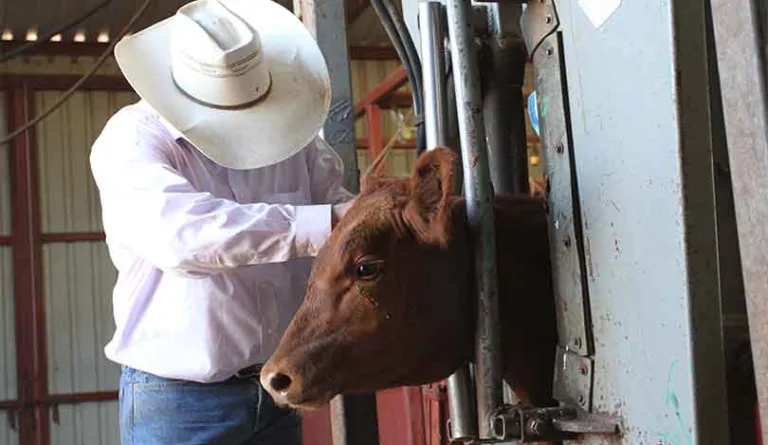WASHINGTON, DC – Nearing the end of the year, the November 9th World Agricultural Supply and Demand Estimates (WASDE) Report paints a good picture of how the 2021/2022 outlook is shaping up.

U.S. corn outlook is for greater production, increased corn used for ethanol and marginally lower ending stocks. The soybean outlook for 2021/22 is for lower production and exports and higher ending stocks. Following the release of the report at 12pm ET, Nov. 9, soybean and corn futures turned higher, while wheat built on its earlier gains.
The USDA’s next set of supply, demand, and production estimates is out December 9th
LIVESTOCK, POULTRY, AND DAIRY: The forecast for 2021 total red meat and poultry production is raised from last month. Beef production is raised from the previous month on higher expected slaughter of fed cattle and heavier carcass weights.
The pork production forecast is raised slightly as heavier carcass weights more than offset lower expected slaughter in the fourth quarter.
The broiler production forecast is raised on recent hatchery and slaughter data. Turkey production is raised on September production data; no change is made to the fourth quarter production forecast. The egg production forecast is raised on recent production data and higher expected table egg production in the fourth quarter.
For 2022, the total red meat and poultry forecast is raised slightly from last month. Beef and turkey production forecasts are raised, while the pork and broiler production forecasts are unchanged from last month. The egg production forecast is raised from last month.
The 2021 and 2022 beef import forecasts are raised from last month on robust domestic demand for beef. The 2021 beef export forecast is raised on recent trade data and continued strong demand from top trading partners. No change is made to the 2022 beef export forecast.
Pork exports are reduced on September trade data; no change is made to the forecasts for outlying periods.
Broiler export forecasts for 2021 and 2022 are raised on stronger expected demand. The 2021 and 2022 turkey export forecasts are raised modestly from last month.
Cattle price forecasts for 2021 and 2022 are raised on continued firm demand.
The hog price forecast is reduced for fourth-quarter 2021 on recent price weakness. This weakness is expected to carry into first-quarter 2022, and the annual price forecast is lowered.
The 2021 and 2022 broiler and turkey price forecasts are raised from the previous month on current prices and expected strength in demand.
The milk production forecasts for 2021 and 2022 are reduced from the previous month on lower expected dairy cow numbers and slower growth in milk per cow. Fat basis import forecasts for 2021 and 2022 are reduced on lower expected imports of butterfat products. Fat basis export forecasts for 2021 and 2022 are raised on higher expected exports of cheese and butterfat products. The skim-solids basis import forecast for 2021 is raised while 2022 imports are unchanged from last month. The 2021 and 2022 skim-solids basis export forecasts are unchanged from last month.
Butter, nonfat dry milk (NDM), and whey price forecasts for 2021 are raised from last month on strength in demand and lower expected production. The cheese price forecast for 2021 is reduced on current prices and continued large supplies. The 2021 Class III price forecast is reduced from last month as the lower forecast cheese price more than offsets the higher whey price. The Class IV price forecast is raised on higher NDM and butter prices. The 2021 all milk price forecast is raised to $18.50 per cwt.
For 2022, cheese, butter, NDM, and whey price forecasts are raised on strength in demand and lower expected milk supplies. The 2021 Class III and Class IV price forecasts are raised WASDE-618-5 on higher forecast dairy product prices. The all milk price for 2022 is raised to $20.25 per cwt.
COARSE GRAINS: This month’s 2021/22 U.S. corn outlook is for greater production, increased corn used for ethanol, and marginally lower ending stocks.
Corn production is forecast at 15.062 billion bushels, up 43 million from last month on a 0.5-bushel increase in yield to a record 177.0 bushels per acre. Corn used for ethanol is raised 50 million bushels, based on September data from the Grain Crushings and Co-Products Production report and weekly ethanol production data as reported by the Energy Information Administration for the month of October.
With use rising slightly more than supply, corn ending stocks are lowered 7 million bushels. The season-average corn price received by producers is unchanged at $5.45 per bushel.
Global coarse grain production for 2021/22 is forecast 5.1 million tons higher to 1,499.0 million.
This month’s 2021/22 foreign coarse grain outlook is for larger production, increased trade, and higher stocks relative to last month. Foreign corn production is forecast higher as increases for Argentina, the EU, and several African countries more than offset a decline for the Philippines.
For Argentina, production is raised mostly reflecting increased area expectations for late-planted corn. Corn production in the EU is higher based on increases for Poland, Romania, and France. Foreign barley production is lowered based on declines for Turkey, the EU, Russia, and Ukraine.
Corn exports are raised for Argentina and the EU but lowered for Bangladesh. Corn imports are raised for Iran and Thailand but lowered for Nigeria and Turkey. For 2020/21, corn exports for Argentina are raised but reduced for Brazil for the local marketing year beginning March 2021, based on shipments observed through October.
For 2021/22, barley imports are raised for China and Turkey but reduced for Saudi Arabia.
Foreign corn ending stocks are higher relative to last month, reflecting increases for China, Brazil, Burkina Faso, and Angola. Global corn ending stocks, at 304.4 million tons, are up 2.7 million.
OILSEEDS: The U.S. soybean outlook for 2021/22 is for lower production and exports, and higher ending stocks. Soybean production is forecast at 4.42 billion bushels, down 23 million on lower yields. Lower yields in Indiana, Iowa, Ohio, and Kansas account for most of the change in production.
Exports are reduced this month reflecting reduced global imports and lower-than-expected shipments through October. With use falling more than supply, soybean ending stocks are raised 20 million bushels.
The U.S. season-average soybean price for 2020/21 is forecast at $12.10 per bushel, down 25 cents. Soybean meal and oil prices are unchanged at $325.00 per short ton and 65.0 cents per pound, respectively.
Global 2021/22 soybean production is reduced 1.1 million tons to 384.0 million as lower production for the United States and Argentina is partly offset by higher Indian production. Argentina’s production is lowered 1.5 million tons to 49.5 million on a lower harvested area. Production for India is raised 0.9 million tons to 11.9 million based on data from the Soybean Processors Association of India.
Global soybean exports are lowered 1.0 million tons to 172.1 million, with lower exports for Argentina and the United States partly offset by higher exports for Brazil and India. With lower exports, China’s imports are reduced 1.0 million tons to 100 million.
Global soybean stocks are reduced 0.8 million tons to 103.8 million as lower stocks for Argentina and China are partly offset by higher U.S. stocks.
WHEAT: The outlook for 2021/22 U.S. wheat this month is for lower supplies, higher domestic use, reduced exports, and slightly higher ending stocks. Supplies are reduced on lower anticipated imports, down 10 million bushels to 115 million on a continued weak import pace.
Higher anticipated seed use for the 2022/23 crop more than offsets lower expected food use driven by a slower-than-expected pace of flour milling as reported in the quarterly NASS Flour Milling Products report. As a result, total domestic use is projected 2 million bushels higher at 1,163 million. Exports are lowered 15 million bushels to 860 million, on lower anticipated exports of Hard Red Spring and White wheat based on high domestic prices and muted export sales.
Projected 2021/22 ending stocks are raised slightly to 583 million bushels, up 3 million from last month’s forecast but still the lowest U.S. ending stocks since 2007/08. The projected 2021/22 season-average farm price is raised $0.20 per bushel to $6.90 on reported NASS prices to date and expectations on cash and futures prices for the remainder of the marketing year.
The global wheat outlook for 2021/22 is for reduced supplies, slightly higher consumption, increased trade, and lower ending stocks. Supplies are projected down by 1.0 million tons to 1,063.2 million based on decreases in beginning stocks and production.
World production is lowered 0.6 million tons to 775.3 million as decreases in the EU, the UK, and Uzbekistan more than offset an increase for Russia. EU production is lowered primarily due to downward revisions in France and Germany that are only partially offset by an increase in production in Romania. Russian wheat production is estimated 2.0 million tons higher to 74.5 million based on Ministry of Agriculture harvest results that lowered harvested area but increased yields for both winter and spring wheat.
World consumption is raised 0.4 million tons to 787.2 million, primarily on feed and residual changes as increases for Russia, Iran, and Turkey more than offset reductions for the EU, the UK, Ukraine, and Uzbekistan.
The global forecast for trade is increased 3.5 million tons to a record 203.2 million, primarily on higher exports from the EU, India, Russia, and Ukraine. Projected global ending stocks are down 1.4 million tons to 275.8 million, with Australia, the EU, and India accounting for most of the reduction.
RICE: The outlook for 2021/22 U.S. rice this month is for increased supplies, higher domestic use, lower exports, and larger ending stocks.
Supplies are raised as NASS increased rice production by 3.3 million cwt to 193.8 million, all on higher yields. The all rice yield is forecast at a record 7,756 pounds per acre, up 131 pounds from the previous forecast. Record yields are forecast for Arkansas, California, Mississippi, and Missouri. This increase in supply is partially offset by a reduction in imports, all long-grain, as monthly Census imports continue to run below last year’s pace.
All rice imports are reduced 1.0 million cwt to 35.0 million but remain above last year. Domestic and residual use is raised 1.5 million cwt to 147.5 million on increased supplies. Exports are reduced by 1.0 million cwt to 90.0 million, all for long-grain on a weaker-than-expected pace of sales and shipments.
Projected 2021/22 all rice ending stocks are raised 1.8 million cwt to 35.0 million but are still down 20 percent from last year. The projected 2021/22 all rice season-average farm price is unchanged at $14.80 per cwt and up from a revised $14.00 for 2020/21.
The 2021/22 global outlook is for larger supplies, reduced consumption, minimally lower trade, and increased stocks. Rice supplies are raised 3.3 million tons to 699.2 million, primarily on increased beginning stocks for India and higher production for several countries in Sub Saharan Africa.
Global 2021/22 consumption is lowered 1.0 million tons to 511.3 million but remains a record as a reduction for India is partially offset by increases for several Sub Saharan Africa countries.
World trade is fractionally lower at 49.7 million as higher exports by India are more than offset by reductions for China, Burma, and the EU. India’s exports are raised 0.5 million tons to 19.0 million, which is the second highest on record, following a revised 20.2 million for 2020/21.
Projected 2021/22 world ending stocks are raised 4.3 million tons to a record 187.9 million, primarily on increases for China and India, which account for 60 and 20 percent of global stocks, respectively
SUGAR: U.S. beet sugar production for 2020/21 is increased by 60,682 short tons, raw value (STRV) to 5.092 million on higher-than-expected beet sugar production in September. Beet sugar production for 2021/22 is increased by 65,544 STRV to 5.413 million on processors’ forecast of beet sugar production from slicing (increase of 112,372 STRV) less adjustments made for August-September production in 2021 and projected 2022 (decrease of 46,829 STRV).
Cane sugar production in Louisiana is decreased by 20,021 STRV on a lower crop yield forecast by NASS, a slightly lower sucrose recovery forecast by processors, and adjustments made for September production in 2021 and 2022.
Imports for 2020/21 are reduced by 56,719 STRV to 3.195 million on final trade data for September 2021 from U.S. Customs and Border Protection and U.S. Census. On October 29, 2021 the USDA extended the period for the entry of 2020/21 raw cane TRQ sugar to December 31, 2021, and on November 3, USTR announced a reallocation of 29,442 metric tons, raw value from countries stating they do not intend to export their assigned quota. It is estimated that an additional 19,842 STRV will enter as a consequence of these two actions.
The 2020/21 raw sugar shortfall decreases from 74,957 STRV last month to 55,116. Hightier tariff imports for 2021/22 are increased by 25,000 STRV after the importation of high-tier tariff raw sugar in October by a major U.S. refiner.
Sugar use for 2021/22 is unchanged from last month but is reduced for 2020/21 by 55,863 STRV. Deliveries for human consumption for 2020/21 are estimated at 12.109 million STRV, a decrease of 90,835 and arguably attributable to challenges faced by refiners after Hurricane Ida. Cane sugar deliveries for September were 9.4 percent below the average of the previous 5 years and at the lowest level since 2011/12.
Ending stocks for 2020/21 are reported in Sweetener Market Data at 1,728,209 STRV for an ending stocks-to ratio of 14.0 percent. Ending stocks for 2021/22 are residually projected at 1,765,294 STRV for an ending stocks-to-use ratio of 14.3 percent.
Mexico sugar production for 2021/22 is projected at 5.979 million metric tons (MT), an increase of 39,000 over last month due to good moisture in most growing areas. The USDA forecast is about 137,500 MT less than the CONADESUCA forecast made by authorities in Mexico due mainly to differing forecasts of factory yields. Deliveries for 2021/22 are down from last month by 13,962 MT on a continuing decline in human consumption only partially offset by increased deliveries to the IMMEX program for the export of sugar-containing products.
Ending stocks are reduced by only a small amount needed to meet use in 2022/23 before the start of sugar production in mid-November of 2022. Exports are residually increased by 99,314 MT to 1.777 million
COTTON: This month’s 2021/22 U.S. cotton estimates are largely unchanged from October. The U.S. production forecast is slightly higher, at 18.2 million bales, while domestic mill use and exports are unchanged.
U.S. ending stocks are 200,000 bales higher at 3.4 million—19 percent of use—and 250,000 above the previous year.
The projected marketing-year average price received by upland producers is unchanged this month at 90 cents per pound, a 36 percent year-to-year increase.
The global cotton balance sheet for 2021/22 includes higher production and consumption, and slightly lower ending stocks. Beginning stocks this month are also lower, by 1 million bales, due to higher estimated consumption in earlier years for India, Pakistan, and Mexico. Their projected use in the current year is also higher this month, and total global consumption is up 700,000 bales.
The world production forecast is 1.5 million bales higher as gains for Brazil, Australia, Pakistan, and the United States more than offset a 200,000- bale decline in Greece following unusually heavy October rainfall.
World ending stocks are projected at 86.9 million bales, 200,000 bales lower than in October, and 2.4 million bales lower than in 2020/21.












